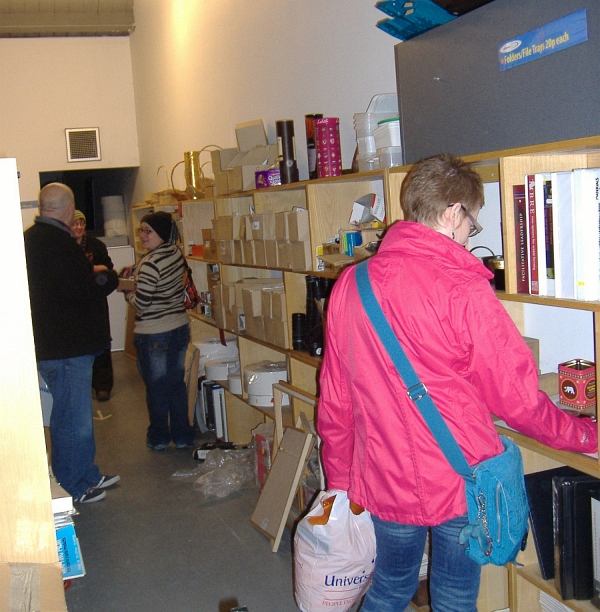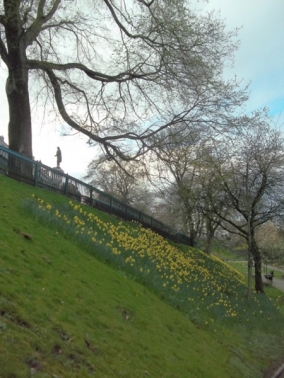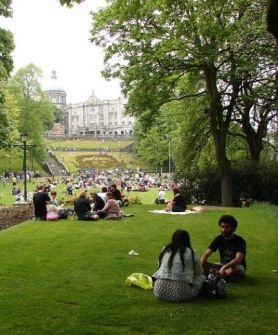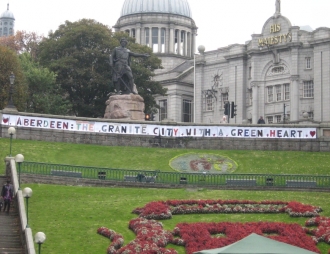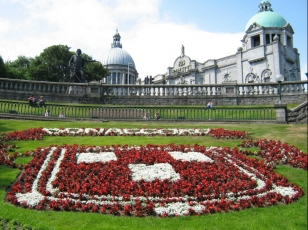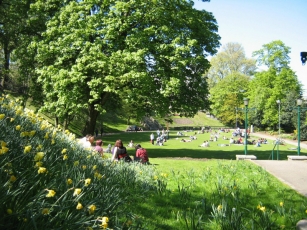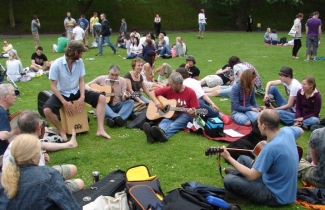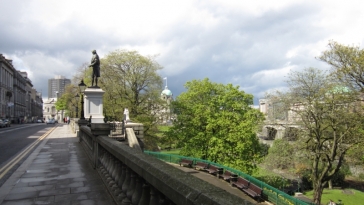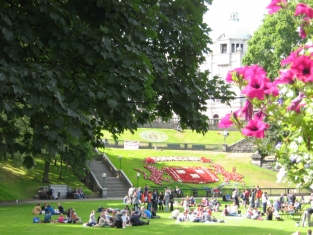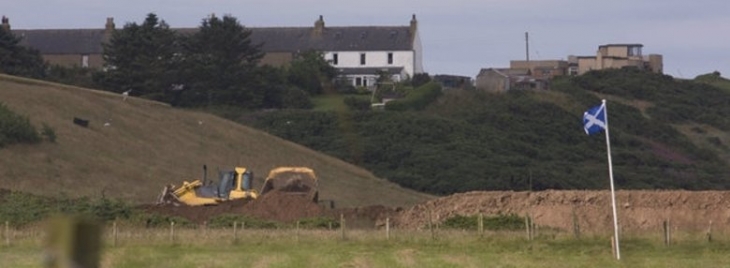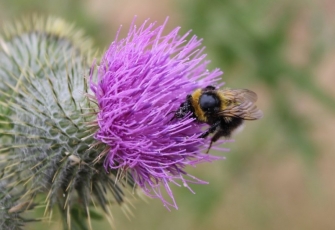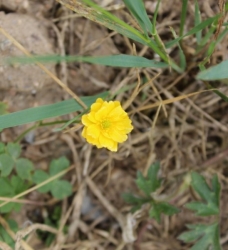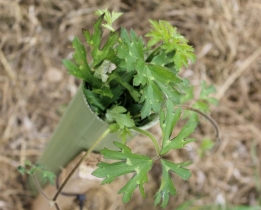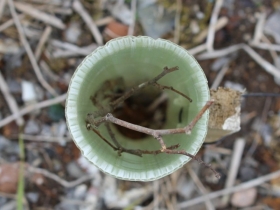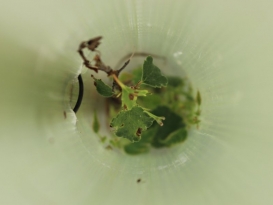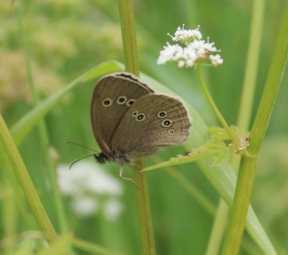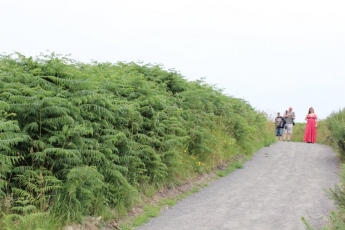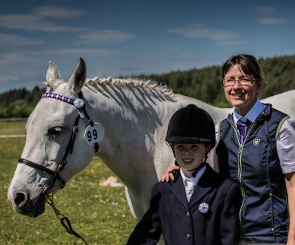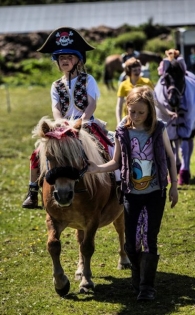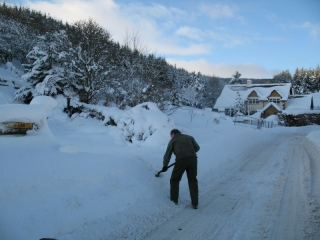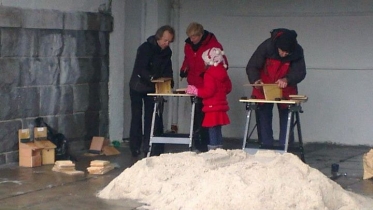By
Suzanne Kelly.
The Press & Journal devoted its first five pages on 21 August to august business mogul Sir Ian Wood.
On the following day, while the Scotsman put the Ian Wood ultimatum on Page 23 (with the little matters of Syria and other news taking precedence), our P&J had Alex Salmond on the cover entreating us to take the Wood shillings, and the following three pages were likewise dedicated to the granite web (with one pro-Trump article also up front, undoubtedly for balance).
This ceaseless Aberdeen Journals attempt at blatantly trying to rewrite history ignores reality. The AJL owners must be convinced the public will buy into the brainwashing and forget the past. From what I’m told, this propaganda is not appreciated by a web-wearied (and possibly dwindling) readership.
The details which the P&J brazenly try to paper over may be of interest to anti-granite web factions. Those who had to fight against an onslaught of propaganda during the non-binding referendum need to be able to counter this latest myopic, self-serving pro-web media onslaught; a round up of the issues may help with this.
During the referendum a wave of factually inaccurate, expensive, garish leaflets and newspapers (created by an anonymous, clearly well-off group) bombarded City (and accidentally shire) residents. Let’s make sure the oversimplified argument ‘Aberdeen must take this generous £50 million gift’ is one gift horse that is looked in the mouth, pronounced diseased, and refused (again).
Here are a few select counter-arguments which the Press & Journal conveniently overlook.
1. Ian’s promises to go away
Wood was going to abandon the plan if the first consultation for the city garden project indicated the public didn’t want it. The illustrations which first did the rounds clearly showed a flat, barren, concrete or tile giant square, with one or two plants in a pot.
The public didn’t want this and said so. Ian Wood however did not go away. The pro City Garden Project factions then accused the public of not understanding the illustrations, claiming the drawings looked nothing like what was really on offer. And back they went to the drawing board, rather than backing away as initially promised.
All this time, the taxpayer was paying the bill via invoices submitted to the City via unelected quango, Aberdeen City and Shire Economic Future (formerly Forum – they created their own manifesto).
See: https://aberdeenvoice.com/2012/02/the-great-city-gardens-project-gravy-train/
I have lost count of the headlines similar to the current ones in which Sir Ian threatens to send his money to Africa, take the offer off the table, etc.etc. But one thing seems clear to me: this is not a man of his word, going by these broken promises alone.
1.1 Alex Salmond to the rescue? Has Salmond learned nothing from his intervention with Trump?
Ian and Alex Salmond shared correspondence, and the web was one of their topics. Salmond has again come to bat for his friend, and is flexing his muscle in the same city where he recently disregarded the rules and protocol, sauntered into a primary school during a by election and had a press and photo call.
One friend helping another is a heart-warming thing. Here is an excerpt from Wood to Salmond correspondence:-
“I have been particularly grateful for the support your Government have provided to the Aberdeen City Centre Regeneration Project which, as you know, I believe is vitally important for Aberdeen’s long-term economic future and wellbeing.
“The vote of Aberdeen City Council on 22nd August will be crucial, and if this is positive I will obviously allocate some of my time to support the development phase of this project in any way I can, and I know there will be an important role for Scottish Government to play in facilitating this. If the vote is negative, Wood Family Trust will have no choice but to withdraw their offer of funding.”
See – https://aberdeenvoice.com/2012/11/wood-to-salmond-01-08-12/
Let’s not forget Sir Ian’s signature appears on a letter to the First Minister from Aberdeen City Gardens Trust (which is meant to be Smith, Crosby and Massie). If he had control at ACSEF, over Salmond, and over the ACGT, then he pretty much will be calling all the shots should this web ever be woven. https://aberdeenvoice.com/2012/12/salmonds-web-exclusive-correspondence-revealed/
28 July 2012: Aberdeen City Gardens Trust, ACSEF and Wood to Salmond
“The concept designs will be available to exhibit to the public late September with the public asked to indicate their views… with the winning concept design presented to Aberdeen City Council to endorse.
“The current plan is that by mid-December the city council will be in a position to approve the TiF business case prior to it being submitted to the Scottish Futures Trust. It goes without saying that the Project will not proceed without TiF funding.
“We’d be very happy to discuss this with you further… We will also be seeking some further discussion with John Swinney…”
See – https://aberdeenvoice.com/2012/11/wood-smith-acgt-acsef-to-salmond-28-07-11/
The striking feature of this letter is that it indicates the city council is not in the driving seat.
The council is expected not to debate or vote; it is expected to ‘endorse’ and ‘approve.’
The Aberdeen City Gardens Trust (ACGT) is a private entity set up to run the City Gardens Project that listed Tom Smith (also of ACSEF, and formerly Aberdeen & Grampian Chamber of Commerce) and Colin Crosby (A&GCoC) as its two directors.
It is therefore of further interest to note that in this letter of 28 July 2011, ACGT lobbies Salmond with praise for the scheme and seeks further meetings with both Salmond and Sturgeon.
There is the statement that the project will not proceed without TIF. Wood is still chasing it.
Despite many past promises (see previous Aberdeen Voice articles) Wood’s not going to go away any time soon. This being the case, it’s best to recollect some of the history of this saga.
2. The people were ignored when they rejected the web – twice; then the referendum was called. Labour rightly said the referendum was not legally binding and that they would not build the web if elected. They were elected. Any arguments about ‘people being ignored’ discount the past disregard pro-web forces showed when the public went against them.
Despite people like Rita Stephen visiting companies to talk up the new project, and telling groups that Peacock was not going to happen (before it had been officially killed off it seems to me), people said ‘no’ to the giant square. For that matter, I deliberately used the word ‘preposterous’ in my feedback during the first consultation. This word and my feedback never showed up on their master list of comments. I wonder how many other anti-square comments were omitted?
Eventually the Granite Web was selected as the project of choice. We didn’t get the chance to vote to keep and improve the gardens, even though councillors such as Willie Young were minuted as saying they wanted the public to have this option at an early stage. Letting us vote not to do any project, but to clean up and improve the gardens could have saved a great deal of time and money.
Gerry Brough, now departed from the Council, was minuted at the time as saying the public were not going to get this chance – by the wish of unelected members of other web-related committees. So, the web triumphed, and its drawings were put forward.
3. The web is hideous, makes not spatial or aesthetic sense, and that’s just the concept drawings. It would look far worse if ever built.
Lurid giant flowerbeds sprouted; children played, a woman sunbathed on top of a potato-chip-shaped wedge overhanging an outdoor theatre.
Giant ramps at steep angles jutted to the sky and back sharply down (for no apparent utilitarian purpose).
This was particularly insulting.
One of the propaganda fallacies which seem to stick is the gardens can’t be accessed.
Yes they can; there is a short, gently sloping ramp next to His Majesty’s Theatre; cars get in; people with prams and wheelchairs get in. And yet, the web proposes that these ramps will have some form of function.
If the public didn’t understand the drawings of the flat giant square, which seemed rather easy to grasp, why has no one from the pro-web side ever produced drawings showing what precisely the gardens would look like if they got a thumbs up?
Where are the Heating, Ventilation, Air Conditioning vents that would have to stick up from the garden to serve the underground spaces? Where are the drawings of the required safety features that would stop people jumping or falling from the potato chip wedge?
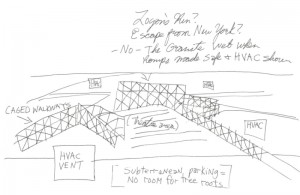
Click on pic to enlarge.
Where are the drawings showing what the granite-clad ramps would look like when they are made safe from people falling, jumping, or quite likely throwing objects on those below?
Stop and think for a moment what a disaster the real garden, fitted with legally required safety measures would look like.
I’ve put my hand to making one such drawing, and I welcome the architects’ submission of a fully safe, legally compliant drawing.
4. A gift is not a gift if you are told how to use it – and that you have to stump up £90 Million to get it.
I keep receiving junk mail, saying I’ve won a valuable prize. All I have to do to get that prize is to spend my own money to claim it. This type of sham sadly does take in some people. Sir Ian’s offer is its relative.
He will only give us this gift if we surrender our common good land, the park, to a private company, Aberdeen City Gardens Trust. There is no other use Wood will accept it seems for his ‘gift’ but to build in the park. And we have to pay nearly twice as much (by conservative estimate) to get rid of our park for parking, shops and a web.
TIF would have been a risk; this is undeniable. If the thing didn’t make money – and the projections were ridiculously high for its income and jobs creation (see past Aberdeen Voice issues), then the taxpayer would be stuck. TIF was never risk free, whatever anyone says – a loan of any kind is a risk, let alone on an unprecedented building work.
If it were a gift, it could have been put in the common good fund, for the city to decide how it were best spent. This is not a gift.
5. So – what did happen to Peacock? Who had a role in its demise?
Peacock raised funds, came up with a plan (which did not please everyone, but it was far more architecturally and environmentally sound than the granite web). It was getting advice from Scottish Enterprise, which initially seemed happy to go along with the Peacock scheme.
Here is an extract from February 2009 from unelected quango, ACSEF’s minutes:
“The small sub-group which will drive the project forward will comprise ACSEF Board/MT members, supported by Zoe Corsi in her communication role. It will be chaired by Dave Blackwood, with Andrew Murphy, Mike Salter, Tom Smith, Abigail Tierney and David Littlejohn as core members, with others, including Andy Willox and Melfort Campbell, available to support as required. Dave Blackwood invited any other Board members who wished to be involved to advise him.
“Abigail Tierney will be the main interface with Peacock Visual Arts, supported by Dave Blackwood as required. Dave Blackwood will be the main contact with Sir Ian Wood and his representative Jennifer Craw.
“The Board will be provided with a summary outlining the facts around public funding to Peacock Visual Arts, key deliverables and timelines expected for the technical appraisal.
“The ACSEF website set up following Sir Ian Wood’s announcement has fulfilled its function and will be closed shortly, with clear communication on next steps.”
And then Peacock was dead, and Sir Ian’s city gardens project rose from the ashes.
Tell us exactly how this transformation came about Sir Ian, for we should be told.
You could have contributed to Peacock’s plan; even using remaining funds from your £50 million donation to embark on other projects, or (perish the thought) helping people in Aberdeen city and shire directly.
Our residential care homes, our schools, our arts education, our people with special needs could have benefitted, and there could have been a project to bring people back from the Union Square Mall into the city centre (should the mall have been approved in the first place, and what were the financial projections for the future of the existing independent retailers? It certainly has harmed city centre businesses).
Then Ian Wood, former Chair of Scottish Enterprise http://www.scotland.gov.uk/News/Releases/2000/06/f1eb0785-1ad2-4379-8fc1-9dd399024b7b decided, while SE was meant to be helping Peacock,to build a web. Peacock didn’t stand a chance.
Until we know all of the facts behind this volte face, you have to wonder what kind of ethics were in play. Speaking of ethics, a few more things to remember.
6. Spending other people’s money is easy as history shows – would this project turn into a mega cash cow and construction/consultation jobs for the usual suspects?
You could certainly be forgiven for asking this question. Here is a little piece on Sir Ian’s old Scottish Enterprise, and how while axing jobs, hospitality sucked up budget http://www.express.co.uk/news/uk/193483/Outrage-over-Scottish-enterprise-chiefs-1m-hospitality-bill
Who would be keeping an eye on the spending for the web, the inevitable onslaught of consultants, the construction and likely overruns? Is this a gift horse or a cash cow for the boys? If ACSEF managed to bill the city for pro-web propaganda including £150 to take a picture showing the park to be ‘inaccessible’ what hope is there that people would act responsibly with £90 million of taxpayer-backed loans?
The original Aberdeen City Gardens Trust companies were private individuals – the usual suspects Tom Smith and Co., with no major project management or architectural skills on this scale. Would they really be in a position to manage this project keeping a reign on finances?
Arguably, Wood didn’t think so – he felt it necessary to pledge millions more for cost over-runs.
Some firms have done quite nicely so far; see https://aberdeenvoice.com/2012/02/the-great-city-gardens-project-gravy-train/
But as his pledges to back off if the garden project got the thumbs down have been conveniently ignored, and replaced by blackmail threats such as his latest pledge to put a project on the table which he will approve of by Christmas or he’s off to Africa with his £50 million, can you believe the over-run pledge or any pledge for that matter. And speaking of Africa…
7. Venture Philanthropy and helping Rwanda’s…Tea Plantation Owners
I invite the Wood Family Trust to explain how much money it has to hand, and how much it is spending on pensions for its members (when I last looked at the Office of the Scottish Charities Register, just under £30 million is sitting around, unused, and pensions were being paid to its members, who are the Wood Family plus Jennifer Craw…)
They can do whatever they want with their money; they can pay generous pensions to their board members. They may even be able to take this money to Africa. Will it go on victims of Rwanda’s social and health problems? Not directly – it will go to producing more tea. How this can be done without cutting more forest down will be interesting to learn; and I invite them to enlighten me.
Venture Philanthropy seems to be a newish phenomenon where the ‘donors’ sometimes expect some form of return for their ‘donation.’
8. Democracy out the window if the web comes in
There are planning laws; there are procedures for those who want to build. We have common good land; it is Union Terrace Gardens. If we give control of our land to Tom Smith and Co. in an unaccountable, arm’s-length company to build Wood’s web, where does that leave the right of the common man?
10. If you wanted to put something back into the community Sir Ian – why did you take £22K from a struggling local authority to pay for an ‘educational’ pilot promoting the idea of entrepreneurship?
Not only are people good at spending taxpayer money; they are also good at clawing money back from the taxpayer.
The city also paid the WFT £22,000 for an educational pilot scheme
The Wood Family Trust invoiced Aberdeen City Council for a pilot programme based on entrepreneurial philosophy. A billionaire taking money from the local council to carry out his programme, and wanting us to consider his generosity at the same time.
Wood Family Trust
The Wood Family Trust (WFT) is listed as having paid £160,000 towards the CGP referendum. The taxpayer chipped in £40,000.
The city also paid the WFT £22,000 for an educational pilot scheme involving Kincorth Academy ‘per contract’. What contract ACC and the WFT have entered into will make interesting reading. Perhaps other charitable trusts have contracted with ACC – but why a charity should be engaged by contract on an educational scheme is at present unclear.
https://aberdeenvoice.com/wp-content/gallery/images2/wood-family-trust-get-22-k-from-acc-nov-11.jpg
10. The granite web won’t cost the taxpayer anything. Rubbish. It’s cost us plenty already which could have gone on people – or just plain improving the gardens
Here is a small extract from the ‘Gravy Train’ article (link above).
| Item |
Description |
Date |
Amount |
| 1 |
Technical Feasibility Study to undertake an engineering, cost and design appraisal of the development options for UTG, each incorporating an arts centre. |
Jun 2009 |
£162k |
| 2 |
Architect, Design & Project management fees for a Contemporary Arts Centre project |
Feb 09/May 10 |
£226k |
| 3 |
Consultation Report – City Square Project.. |
Mar 2010 |
£113,915 |
| 4 |
Union Terrace Gardens (TIF)-Tax Increment Financing |
Mar 10
Oct 10
Nov 10 |
£71,959.65 |
| 5 |
Scottish Enterprise holds 22 copies of invoices relating to ACSEF approved spend for activities relating to stakeholder engagement, events management, and communications. [sic] |
2009-10
2010-11 |
£51,766.60
£22,712.72 |
(source – Scottish Enterprise email exchange with Suzanne Kelly May 2011)
11. Speaking of morals – how about just paying the full amount of tax you should Sir Ian, without using offshore schemes?
12. Maybe if we had the benefit of his wealth via his fair share of taxes, we could see some real economic, social benefit.
Sir Ian, are you using any tax devices which allow money to avoid taxation, such as offshore payroll arrangements for you or WGPSN employees?
If so, do you think the public’s interests might be better served by your paying your fair share in tax for it to be deployed as government sees fit (not that I have a great deal of faith in government, but there is some democratic hope money will be spent as needed) rather on what is an overblown, badly-designed monstrous vanity project? Just asking.
Uncharacteristically, the P&J carried this on the subject: http://www.pressandjournal.co.uk/Article.aspx/2198187
13. We still need some fresh air. Ridiculous claims of ‘doubling’ the green space by building a web are a thin veneer easily scratched away – as would any turf planted on the raised garden floor would be as well.
This city has very few trees in its city centre. It also has two of Scotland’s most polluted roads according to Friends of the Earth.
Back off our garden; back off our trees.
What if?
If I had a tenth of his money, I would enhance the gardens (let people put in a small play area, let there be a café to encourage social use of the gardens; the parties that have been held are great for bringing people together). The gardens are not the problem.
I would take over brownfield site and regenerate; we could use social meeting places; places for older citizens to gather, places for people with mobility issues to socialize; places for children to safely play, to learn arts, to have fun.
I’d build Peacock or build an arts/social centre on brownfield. I’d give money to the bodies cruelly axed by Kate Dean.
I would not build parking in a garden; I would not chop trees down.
I would not continue to divide a city I had damaged while pursuing my egotistical, self-centered fantasy.
We do not need more shops.
If I had the time, money and energy of the P&J team, I could spin out another 10 pages of reasons why the web has to stay in the dustbin, and why its genesis should be fully investigated. For now I suggest averting your eyes from the P&J, remembering what actually took place, and thanking your stars it hasn’t been built yet.
Better still, tell your elected rep you want the whole thing investigated, the project denounced, and stop buying AJL papers until they start reporting news, not what they want to make happen.
- Comments enabled – see comments box below. Note, all comments will be moderated.
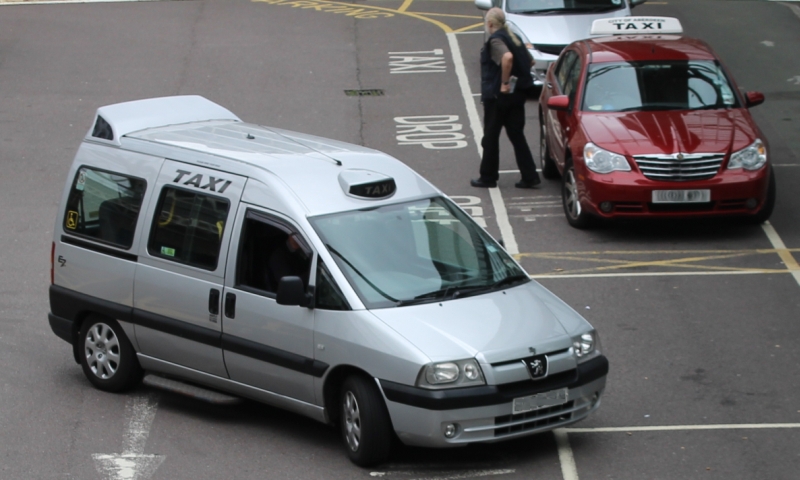 Barney Crockett, whose name incidentally comes up as Blarney with spell checker,
Barney Crockett, whose name incidentally comes up as Blarney with spell checker,

